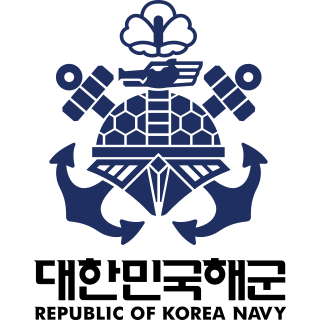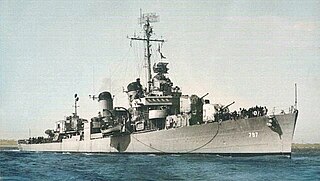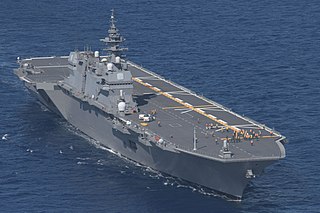
The People's Liberation Army Navy, also known as the People's Navy, Chinese Navy, or PLA Navy, is the maritime service branch of the People's Liberation Army, and the largest navy per number of ships in the world.

The Republic of Korea Navy, also known as the ROK Navy or South Korean Navy, is the naval warfare service branch of the South Korean armed forces, responsible for naval and amphibious operations. The ROK Navy includes the Republic of Korea Marine Corps, which functions as a branch of the Navy. The ROK Navy has about 70,000 regular personnel including 29,000 Republic of Korea Marines. There are about 140 commissioned ships in the ROK Navy. The naval aviation force consists of about 70 fixed-wing and rotary-wing aircraft. The ROK Marine Corps has about 300 tracked vehicles including assault amphibious vehicles.

INS Rana is a Rajput-class destroyer in active service with the Indian Navy. She was commissioned on 28 June 1982.

The Japan Maritime Self-Defense Force, abbreviated JMSDF, also simply known as the Japanese Navy, is the maritime warfare branch of the Japan Self-Defense Forces, tasked with the naval defense of Japan. The JMSDF was formed following the dissolution of the Imperial Japanese Navy (IJN) after World War II. The JMSDF has a fleet of 154 ships, 346 aircraft and 50,800 personnel.

USS Cushing (DD-797) was a Fletcher-class destroyer of the United States Navy, the fourth Navy ship named for Commander William B. Cushing (1842–1874), who distinguished himself during the American Civil War. Cushing was launched on 30 September 1943, by Bethlehem Steel Co., in Staten Island, New York; she was sponsored by Miss Katherine A. Cushing, a daughter of Commander Cushing. The vessel's commissioning was on 17 January 1944.
The Republic of Korea Navy was founded on November 11, 1945 as Marine Defense Group after Korea was liberated from the Empire of Japan. The ROK Navy is the oldest service within the ROK Armed Forces. In 2015, the South Korean navy celebrated its 70th anniversary.

The 2010 Senkaku boat collision incident occurred on the morning of September 7, 2010, when a Chinese trawler operating in disputed waters collided with Japanese Coast Guard (JCG) patrol boats near the Senkaku Islands. There were several JCG boats involved, including Yonakuni and Mizuki, which collided with Minjinyu 5179, plus Hateruma and other JCG boats.

JS Ōnami (DD-111) is the second vessel of the Takanami-class destroyers of the Japan Maritime Self-Defense Force (JMSDF).

China Marine Surveillance was a maritime surveillance agency of China.

JS Mineyuki (DD-124) was a Hatsuyuki-class destroyer of the Japanese Maritime Self-Defense Force.

JS Izumo (DDH-183) is a helicopter carrier which, as of 2022, is being converted into a light aircraft carrier. Officially classified as a multi-purpose operation destroyer, she is the lead ship in the Izumo class of the Japan Maritime Self-Defense Force (JMSDF). She is the second warship to be named for Izumo Province, with the previous ship being the armored cruiser Izumo (1898).

The Shikishima-class patrol vessel is a class of PLH type patrol vessels of the Japan Coast Guard. In the official classification, Shikishima and Akitsushima are treated as the only ships in their classes, respectively; and Reimei is treated as the lead ship of her class. The Shikishima class was once the world's largest coast guard vessel until it was surpassed by the Chinese Zhaotou-class patrol cutter in 2015.

JS Kaga (DDH-184) is a helicopter carrier being converted into an aircraft carrier beginning in March, 2022. Officially classified as a multi-purpose operation destroyer, she is the second ship in the Izumo class of the Japan Maritime Self-Defense Force (JMSDF), the other being JS Izumo. Her namesake arises from Kaga Province in present-day Ishikawa Prefecture.

JS Murasame (むらさめ) is the lead vessel of the Murasame-class destroyers of the Japan Maritime Self-Defense Force (JMSDF).

Japan has the eighth-largest exclusive economic zone (EEZ) in the world. The total area of Japan is about 380 thousand km2. Japan's EEZ area is vast and the territorial waters and EEZ together is about 4.47 million km2.

The 2018 Japan–South Korea radar lock-on dispute is about an incident between a Japanese aircraft and a South Korean vessel. The aircraft was part of the Japan Maritime Self-Defense Force (JMSDF), while the vessel was part of the Republic of Korea Navy (ROKN). The event occurred on 20 December 2018, without the firing of any weapon, and was followed by a large diplomatic dispute between Japan and South Korea.

JS Harusame (DD-102) is the second ship of Murasame-class destroyers. She was commissioned on 24 March 1997.

JS Samidare (DD-106) is the sixth Murasame-class destroyer of the Japan Maritime Self-Defense Force (JMSDF). She was commissioned on 21 March 2000.




















